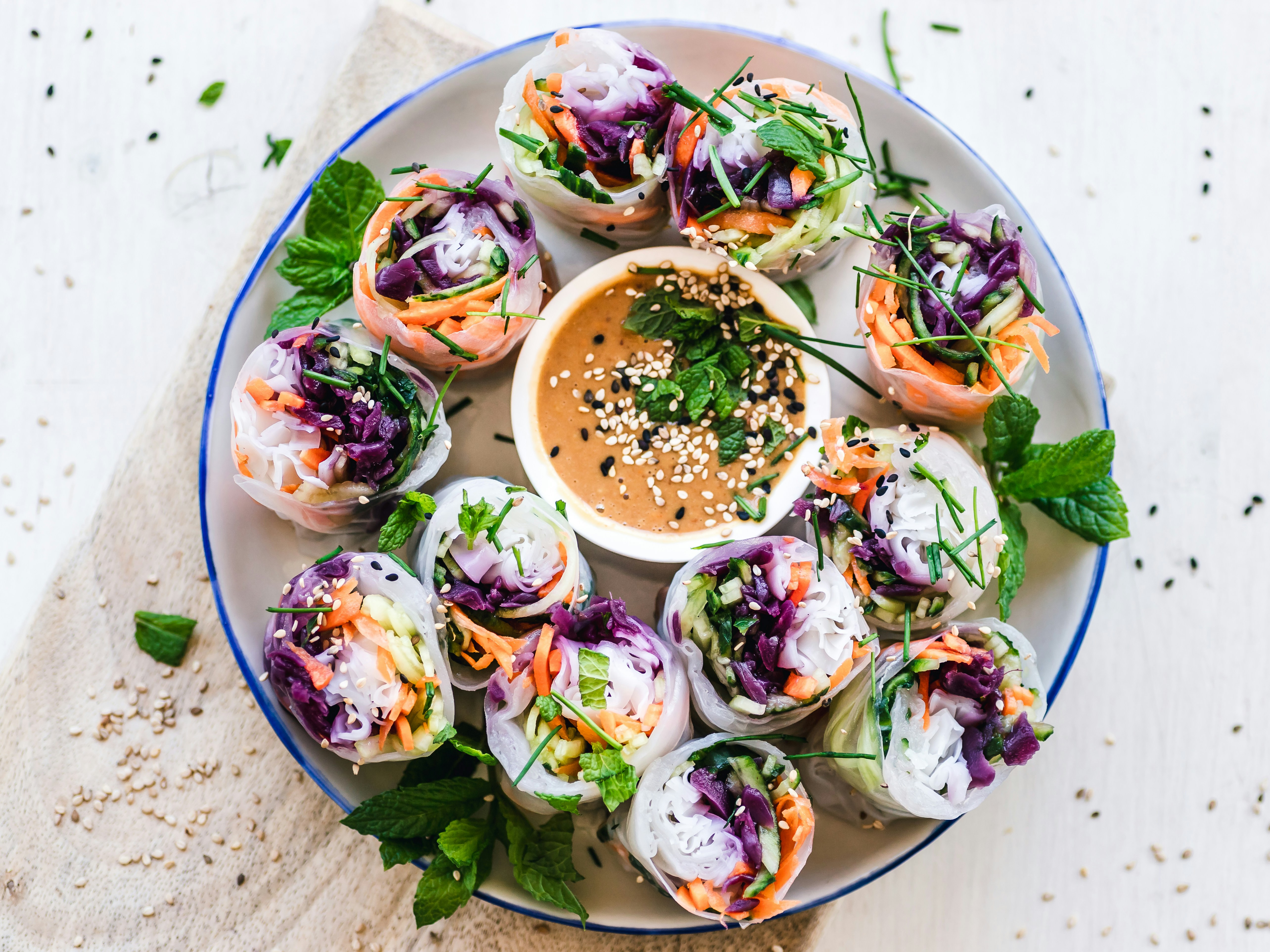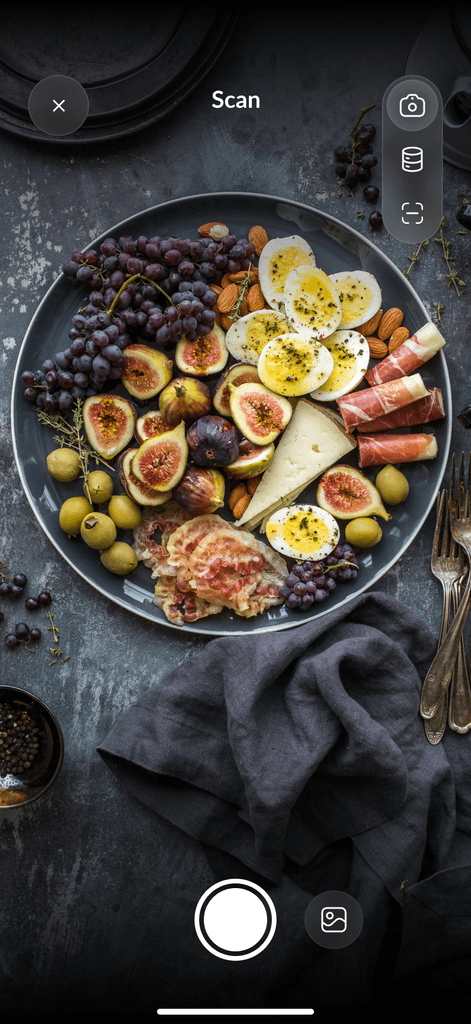Tracking your macros can feel overwhelming, especially if you're new to veganism. Knowing macros and micros and how they apply to your vegan diet will help you achieve your dietary goals faster. This guide What are macros and micros will help you understand vegan macros and how to count them with AI efficiently.
DietAI's solution, AI calorie counter, is valuable for achieving goals. This interactive app takes the guesswork out of counting calories. Simply tell it your dietary preferences, and it will do the rest.
Table of Content
Benefits of a Vegan Diet

1. Relieving Arthritis Pain Naturally
A plant-based diet may ease arthritis symptoms such as joint stiffness, swelling, and pain. Research indicates that this effect is linked to the anti-inflammatory properties of vegan diets. These diets are rich in whole plant foods that contain antioxidants and fiber, which reduce inflammation and may improve arthritis discomfort.
2. Shedding Unwanted Pounds
When people switch to a vegan diet, they often notice weight loss. This is important, as lower body weight decreases the mechanical load on joints, reducing pain and improving mobility. For individuals with arthritis, losing excess weight can relieve stress on painful joints and enhance recovery.
3. Supporting Heart Health
Research suggests that a vegan diet may lower the risk of heart disease. Plant-based diets rich in fruits, vegetables, legumes, and whole grains help reduce blood pressure, cholesterol levels, and blood sugar, all of which contribute to cardiovascular health.
4. Improving Kidney Function
Plant-based diets may improve kidney function by decreasing the intake of animal proteins, which can be taxing on the kidneys. This change can be especially beneficial for those with existing kidney issues or at risk of kidney disease.
5. Reducing Cancer Risk
Some studies indicate that a vegan diet may lower the risk of certain types of cancer, though more research is necessary. The high intake of fruits and vegetables provides antioxidants and phytochemicals that may have protective effects.
7 High-Protein Vegan Macros

1. Seitan: The Juicy Substitute for Meat Lovers
Seitan is a favorite for vegans and vegetarians alike. This juicy, protein-packed meat substitute is made from wheat gluten, the protein in wheat. When cooked, seitan takes on a chewy, meat-like texture that’s perfect for stir-fries, stews, and sandwiches.
One hundred grams of seitan contains 24.8 grams of protein, 4.4 grams of carbohydrates, and 1.8 grams of fat. It’s also a good source of selenium, iron, calcium, and phosphorus. You can find seitan at most health food stores or make your own at home using vital wheat gluten. Just be aware that seitan is not suitable for those with gluten sensitivity or celiac disease.
2. Quinoa: The Nutrient-Dense Superfood
Quinoa is technically a seed, but it’s often grouped with whole grains because of its cooking and eating characteristics. This superfood is gluten-free and a complete protein containing all nine essential amino acids.
One cup of cooked quinoa has 8.1 grams of protein, 39.4 grams of carbohydrates, and 3.6 grams of fat. Quinoa is also rich in magnesium, phosphorus, manganese, and iron. Moreover, it is easy to prepare and can be added to salads, soups, veggie burgers, or enjoyed as a side dish.
3. Soy: The Versatile Protein Powerhouse
Soy is the basis for many vegan protein sources, including tofu, tempeh, and soy milk. Soy products are made from soybeans, which boast an impressive nutritional profile. For instance, one cup of soy milk contains about 7 grams of protein, while 100 grams of firm tofu has 10.1 grams of protein. Both soy milk and tofu are incredibly versatile.
Soy milk can be enjoyed on its own or in smoothies, and it can replace cow’s milk in recipes. Tofu can be incorporated into countless savory and sweet dishes. Tofu takes on the flavor of whatever it’s cooked with, making it easy to add to your favorite meals for a nutritious boost.
4. Green Peas: The Tiny Nutrient Powerhouses
Green peas may be small, but they pack a serious nutritional punch. One cup of cooked green peas has about 8 grams of protein, vitamins A, C, and K, folate, and manganese. Green peas are also a good source of fiber, providing over 25 percent of the recommended daily intake. They can be enjoyed independently, tossed into salads and grain dishes, or blended into soups for added nutrition.
5. Lentils: The Fiber and Protein-Rich Legume
Lentils are a legume family member and come in various colors, including brown, green, and red. This affordable vegan protein source contains 17.9 grams of protein, 39.9 grams of carbohydrates, and just 0.8 grams of fat per cooked cup (about 75 grams).
Lentils are fiber-rich, packing nearly 50 percent of the daily value per serving. They’re versatile and can be used in soups, stews, salads, and even lentil veggie burgers. Lentils are also rich in antioxidants and phytochemicals that promote health and may help protect against certain diseases.
6. Beans: The Flavorful Protein-Rich Legumes
Beans are another type of legume rich in protein and other nutrients. Many varieties of beans, including black, pinto, navy, and kidney, are nutritious. For example, one cup of cooked kidney beans contains 14 grams of protein, 42 grams of carbohydrates, and just 1 gram of fat.
Beans are also an excellent source of fiber, folate, potassium, and health-promoting plant compounds. Research shows that regularly eating beans and other legumes may help lower blood pressure, cholesterol, and blood sugar levels. Plus, they’re incredibly versatile and can be added to various dishes, including soups, stews, salads, and tacos.
7. Chickpeas: The Nutty Vegan Protein Source
Chickpeas, or garbanzo beans, are another nutritious plant-based protein source. One cup of cooked chickpeas contains about 14 grams of protein, 40 grams of carbohydrates, and 2 grams of fat. They’re also an excellent source of fiber, packing 22 grams per serving.
This helps keep you full and satisfied. Chickpeas have a delicious nutty flavor and can be added to soups, salads, casseroles, or pureed to make hummus. Roasted chickpeas also make a tasty, crunchy snack.
Related Reading
• Do Minerals Have Calories
• How Long in a Calorie Deficit to See Results
• How to Use a Food Scale to Lose Weight
• Can You Eat Pizza on a Diet
• Do Carbs Make You Fat
• Why Am I Not Losing Fat in a Calorie Deficit
• What Are Net Calories
• Is the Fitness App Accurate
• How Many Calories Below Bmr to Lose Weigh
How to Count Macros on a Vegan Diet

Use DietAI for Hassle-Free Macro Tracking
Counting macros doesn't have to feel like a chore. It can be downright fun with the right tools. DietAI transforms calorie counting with our AI calorie-counting app. Take a picture of your food, and our app instantly analyzes your meals from a simple photo, delivering accurate calorie and macro information without manual logging. Beyond photo recognition, the app provides comprehensive progress tracking, personalized nutrition insights tailored to your goals, and convenient barcode scanning for packaged foods.
Whether trying to lose weight, gain muscle, or simply maintain a balanced diet, DietAI makes nutrition tracking effortless by eliminating the tedious aspects of traditional food journaling. Download now to effortlessly track your calories and macros with DietAI, the AI-powered app that makes logging meals as simple as snapping a photo. Download today for 80% off!
Determine Your Caloric Needs
Determining your caloric needs is the first step in tracking macros on a vegan diet. Calculate your Total Daily Energy Expenditure (TDEE), which considers your Basal Metabolic Rate (BMR) and activity level. This provides the total calories you should consume daily to maintain your weight. Adjust this number based on your goals:
Weight Loss: Consume fewer calories than your TDEE.
Muscle Gain: Consume more calories than your TDEE.
You can use online calculators or consult a nutritionist to determine your TDEE.
Set Your Macronutrient Ratios
For a vegan diet, a balanced macronutrient distribution is:
Protein: 25–30% of total calories.
Carbohydrates: 40–45% of total calories.
Fats: 30–35% of total calories..
This ratio supports muscle maintenance, energy needs, and overall health.
Account for Fiber Intake
Plant-based diets are typically high in fiber. Since fiber is indigestible, it doesn't provide usable energy, yet it's counted as a carbohydrate on food labels. To ensure adequate energy intake:
Compensate for Fiber
Consume additional digestible carbohydrates equivalent to 50–75% of your daily fiber intake. For example, if you consume 50 grams of fiber daily, aim for an extra 25–37.5 grams of digestible carbs to compensate.
Choose High-Quality Plant-Based Proteins
Incorporate a variety of protein-rich plant foods to meet your protein needs:
Legumes: Lentils, chickpeas, black beans
Soy Products: Tofu, tempeh, edamame
Grains: Quinoa, amaranth
Seeds and Nuts: Hemp seeds, chia seeds, almonds
Meat Alternatives: Seitan.
Combining different plant proteins can provide all essential amino acids.
Sample Meal Plans
Here are examples of daily meal plans with macro breakdowns:
Rest Day
Total Calories: 1,547
Protein: 99g (25%)
Carbohydrates: 173g (45%)
Fat: 51g (30%)
Fiber: 34g
Exercise Day
Total Calories: 1,940
Protein: 119g (25%)
Carbohydrates: 204g (42%)
Fat: 72g (33%)
Fiber: 42g
These plans illustrate how to structure meals to meet macro goals on different activity levels.
How to Follow a Vegan Diet in 9 Simple Steps

1. Make Vegetables the Stars of Your Meals
Stop stressing over what foods to avoid on a vegan diet and focus on what you can eat. Plant-based diets can be rich and delicious; you don’t have to worry about counting calories. If you want to lose weight, that will happen naturally as you replace meat with nutrient-dense foods that satisfy you.
Vegetables can be the focus of your meals instead of the sidekick. Veggie-packed meals are an all-around winning choice. Veggies contain vitamins, like A and K, and minerals, like potassium. They keep your calories in check and, because they are high in fiber, they can help you feel satisfied.
2. Eat a Variety of Foods
To ensure you're getting all the nutrients you need on a vegan diet, it's crucial to eat balanced meals that include a variety of healthy foods. For example, you'll get protein and fiber from beans, and leafy greens are excellent sources of vitamins A, C, and K. Choose produce from all colors of the rainbow to get all the benefits.
Red tomatoes contain heart-healthy lycopene, blueberries have brain-boosting anthocyanins, and orange sweet potatoes have lots of vitamin A to help keep eyes healthy. Looking for meal ideas? Try a simple, well-balanced grain bowl: Top brown rice or quinoa with beans and a mix of sautéed or roasted veggies. Enjoy a simple, well-balanced plate of brown rice and beans with vegetables.
3. Choose Whole Grains
Swapping out refined grains, such as white pasta and white bread, for whole grains, such as brown rice and quinoa, adds iron and B vitamins to a vegan diet—nutrients that are stripped out when the grains are refined. And the extra fiber from whole grains will help keep you full and may even help you lose weight.
4. Discover New Plant-Based Proteins
One thing everyone can do to improve their health is to eat more plant-based proteins. Animal protein sources, like meat and cheese, are high in unhealthy saturated fat. Vegan protein sources are plentiful and include tofu, tempeh, edamame (soybeans), lentils, chickpeas, and beans. Nuts, like almonds and walnuts, and seeds, like sunflower and pumpkin seeds, also deliver protein.
While many people think it's difficult for vegans to eat enough protein, it typically isn't an issue for someone eating a varied diet and consciously including plant-based protein sources. For example, women could meet their daily quota with ½ cups of dry oatmeal (5 grams protein), 2 tablespoons of peanut butter (8 grams), 1/2 cup of chickpeas (5 grams), 1 cup of cooked quinoa (8 grams), 24 almonds (6 grams), 1 cup of cooked whole-wheat spaghetti (7 grams), and 1/2 cup of tofu (10 grams). Men could add just ½ cups of cooked lentils (9 grams) to meet their daily protein requirement.
5. Avoid Assuming Vegan Food Products Are Healthier
Vegan cookies aren't necessarily healthier than regular cookies. And garlic bread made with vegan margarine isn't necessarily healthier for your heart than one made with butter. Processed vegan foods often contain saturated-fat-laden palm oil and coconut oil. Stick to whole, nutritious, vegan foods, such as carrots and hummus, nuts and dried fruit, and whole-grain tortilla chips with guacamole. Enjoying processed vegan foods every so often is fine, but don’t assume they’re "healthy" simply because they're vegan.
6. Focus On Fish-Free Omega-3s
Even when you eat various healthy vegan foods, some nutrients will be hard to come by. DHA and EPA, two omega-3 fatty acids, are essential for eye and brain development and heart health. Omega-3 fatty acids are found mainly in fatty fish like salmon, though the body can make them in small amounts from ALA, another type of omega-3 found in plants like flaxseed, walnuts, canola oil, and soy. Various foods, including soymilks and breakfast bars, are now fortified with DHA. Supplements of DHA/EPA made from algae are also available.
7. Remember Vitamin D
Most people get vitamin D from canned fish like salmon and sardines, and fortified dairy products like milk and yogurt. Vitamin D is also in fortified nondairy milk, such as soy or almond milk, and orange juice. Some mushrooms that have been exposed to UV light are also good sources. When the sun is stronger in the summer, our skin can synthesize vitamin D—hence, the nickname, "sunshine vitamin." The daily value (DV) for vitamin D is 600 IU; some experts say it should be closer to 1,500. Many people, vegans included, may need to take a supplement to hit those numbers.
8. Pump Up Your Iron
Animal proteins like meat and chicken are the best sources of iron, another nutrient that vegans should pay attention to. Vegans can still get this mineral from beans, legumes, and leafy greens, but iron from plant sources (non-heme iron) isn't as easily absorbed as from meat sources (heme iron). To get the most out of plant-based iron, eat iron-rich foods with vitamin-C-rich foods, which help boost absorption. And avoid eating iron-rich foods simultaneously with calcium-rich foods, which can inhibit iron absorption.
9. Make Sure You're Getting Enough B12
Vitamin B12—a vitamin that helps transform food into energy in our bodies and aids in brain function—is found mainly in animal foods, such as meat, fish, poultry, eggs, and dairy foods. People following a vegan diet can get some B12 from fortified cereals or energy bars, but should talk with their healthcare practitioner about taking a supplement. The daily recommended amount for Vitamin B12 is 2.4 micrograms for most adults.
Related Reading
• Carnivore Macros for Weight Loss
• How to Track Calories When Eating Out
• Weight Watchers vs Calorie Counting
• Macros for Mediterranean Diet
• How to Stick to a Calorie Deficit
• Losing Weight and Gaining Muscle
• How to Track Alcohol Macros
• Macros for 1200 Calorie Diet
• Intermittent Fasting and Macros
• Macros for Pcos Weight Loss
• Paleo Macros
Download DietAI Today for 80% Off!
Macros and micros, aka macronutrients and micronutrients, are dietary components that serve distinct, yet equally important roles in overall health. Understanding both can help you achieve your health goals, whether to build muscle, lose weight, or simply maintain a balanced diet. Macros are your body's nutrients to provide energy and build and repair body tissues.
There are three main types of macronutrients: carbohydrates, proteins, and fats. Each has a unique structure and function in the body and provides distinct health benefits. Micros, or micronutrients, are vitamins and minerals that support numerous bodily functions. Unlike macros, we need micros in smaller amounts to support health. However, they’re just as important, and a deficiency in any micronutrient can lead to serious health consequences.
Tracking your calorie and macro intake during intermittent fasting can help you stay on track and reach your dietary goals. DietAI transforms calorie counting with our AI calorie-counting app. Take a picture of your food, and our app instantly analyzes your meals from a simple photo, delivering accurate calorie and macro information without manual logging. Beyond photo recognition, the app provides comprehensive progress tracking, personalized nutrition insights tailored to your goals, and convenient barcode scanning for packaged foods.
Whether trying to lose weight, gain muscle, or simply maintain a balanced diet, DietAI makes nutrition tracking effortless by eliminating the tedious aspects of traditional food journaling. Download now to effortlessly track your calories and macros with DietAI, the AI-powered app that makes logging meals as simple as snapping a photo. Download today for 80% off!
Related Reading
• Endomorph Macros for Fat Loss
• Hitting Macros but Not Calories
• Ketosis vs Calorie Deficit
• Macros for Menopause Weight Loss
• Macros for Bariatric Patients
• Nutracheck vs Myfitnesspal
• Noom vs Myfitnesspal
• MacroFactor vs Carbon


